Last-Minute NYC Holiday Gift Guide 🎁
We’ve created a holiday gift guide with presents for the intrepid New Yorker that should arrive just in time—


Federal Hall, located at 26 Wall Street in Manhattan, was built to be New York’s City Hall and later became the United States’ first capitol building under the newly minted Constitution. Since then, the hall has undergone multiple renovations, and has amassed a great deal of secrets and stories concerning everyone from George Washington to Patrick Swayze.
Federal Hall—then known as City Hall—was built in 1699, when most of the city was still a land of forests and streams, and the aftereffects of the Salem Witch Trials were still reverberating through Massachusetts. The building was the home to the Governor’s Council, the New York Assembly, the Supreme Court, and the city jail.
Many legendary events have occurred since then. The building went through three iterations; it was first redone by Pierre Charles L’Enfant, and was later demolished and replaced by a new building created by the architects Ithiel Town, Alexander Davis, and John Frazee. The Stamp Act Congress met on its steps to protest taxation without representation in October 1765. Meetings that led to the completion of the Articles of Confederation were held inside from 1785-1789. In fact, many of the most instrumental documents in U.S. history were signed here, including the Northwest Ordinance, which set up the states that would become Ohio, Indiana, Illinois, Michigan, and Wisconsin—and, critically, prohibited slavery in these new territories.
Today, Federal Hall stands in a crowded section of Lower Manhattan where it is often overlooked, partly due to the fact that it stands in the middle of the chaos of Wall Street. During its various lifetimes, it has been instrumental to some of the most pivotal moments in history, and has also been the site of lesser-known but equally fascinating events. Read on to discover more about this important landmark, which is a stop on our Hidden Gems of the Financial District tour!
Make sure to join us for our next event, where you’ll hear stories of heroes and rogues that have shaped our history as a country and as a city:
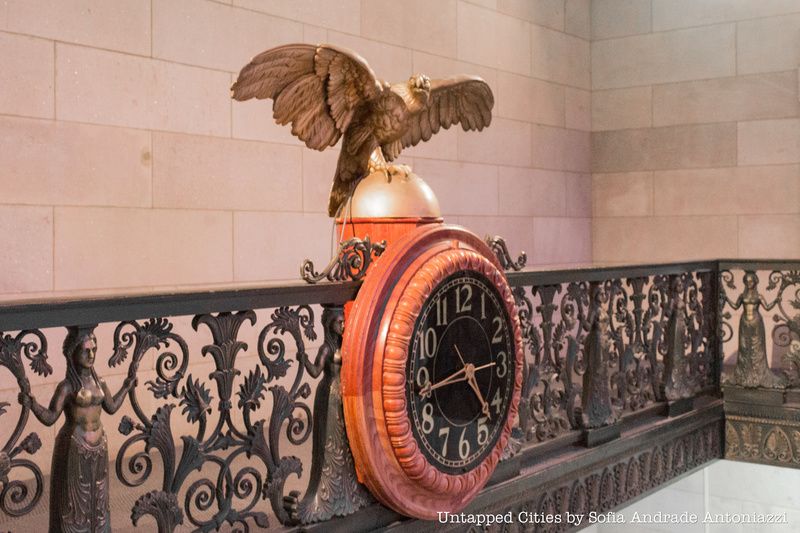
George Washington was famously inaugurated at City Hall in 1789. Standing on the balcony, Washington appeared in a dark brown suit and white silk stockings and proceeded to accept his position as the first president of the United States. The Bible passage read during the ceremony was opened at random, to a passage from Genesis 49:13 (“Zebulun shall dwell at the haven of the sea; and he shall be for a haven of ships; and his border shall be unto Zidon”).
In his inaugural address, Washington addressed the crowd with his characteristic humility and respect, stating: “… I was summoned by my Country, whose voice I can never hear but with veneration and love, from a retreat which I had chosen with the fondest predilection… On the other hand, the magnitude and difficulty of the trust to which the voice of my Country called me, being sufficient to awaken in the wisest and most experienced of her citizens, a distrustful scrutiny into his qualifications, could not but overwhelm with despondence, one, who, inheriting inferior endowments from nature and unpracticed in the duties of civil administration, ought to be peculiarly conscious of his own deficiencies.”
Today, the Bible used in the ceremony can be found at Federal Hall, as well as a few pieces of the original railing balcony on which Washington stood.
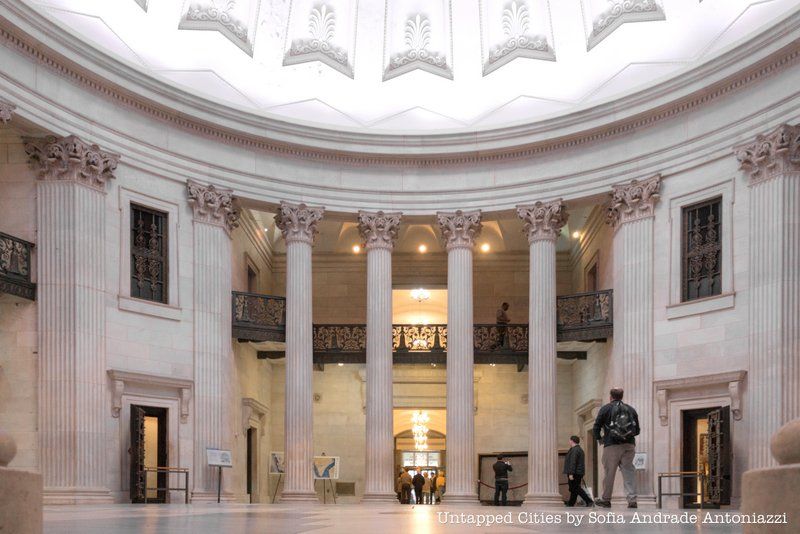
Alexander Hamilton lived close to Federal Hall in the early 1800s. In 1800, just four years before Aaron Burr would famously assassinate Hamilton, the two men worked together as part of the same defense team in a trial that took place in the Old City Hall.
The murder trial involved Levi Weeks, a young carpenter, who was accused of murder when his fiancé was found at the bottom of a well. Burr and Hamilton’s defense led to Weeks’ eventual acquittal after a three-day trial that involved 55 witnesses. They redirected suspicion to a different resident of the boardinghouse where Weeks lived, and the defendant walked out free.
Unfortunately, Burr and Hamilton rarely were able to work quite as well with each other again.
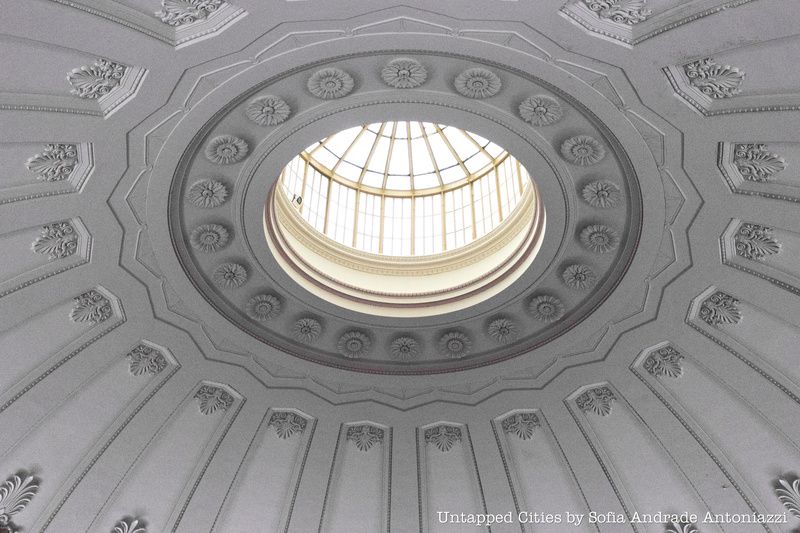
The architects Ithiel Town and Alexander Davis designed the new building to resemble the classical columns of Athens’ Parthenon.
The interior, designed by John Frazee, was modeled after the Pantheon in Rome. The building’s original plans did not include the dome that crowns the building. It was added at the end, in order to let more light in.
The building was made like a fortress; its recessed windows have fittings for protective structures on both the insides and the outsides. The complex network of vaults in the basement have locks made by one of Alexander Hamilton’s companies, designed for maximum security that would protect the reserves of gold and silver that the Treasury kept there when it was based there.
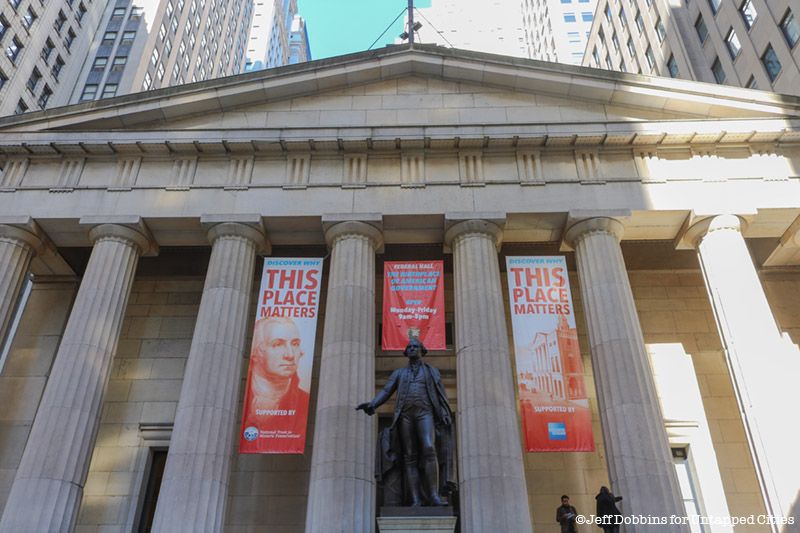
The constant jostling from passing cars and subways below led to structural problems for the Federal Hall Memorial, and over the years, cracks began appearing in its masonry. These problems were made exponentially worse by September 11, 2001, when the cracks widened massively. The National Parks Service brought in Langan Engineering and Environmental Services, who penetrated the ground and discovered that in some areas, there was two feet of empty space between the building and the ground. Parts of the building were literally suspended in air.
To solve this problem, a $16 million renovation effort began, involving 60-foot steel pilings driven into the earth in order to inject liquidized concrete into pre-drilled cavities.
Today, the Federal Hall Memorial has a stronger foundation than ever.
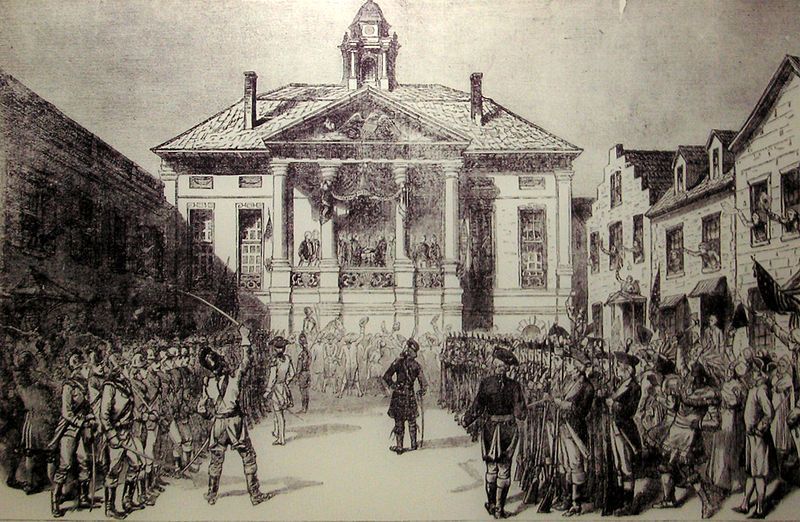
1939 drawing of the Federal Hall at George Washington’s inauguration. Image from Wikimedia Commons
In 1790, the U.S. Capitol was moved to Philadelphia, and so there was no longer a need for a Capitol building in New York. In 1811, the new Federal Hall that still stands today was completed, and the old historic Federal Hall was sold at auction for $425. Its buyer, Ephram Jennings, quickly made plans for the building’s demolition.
As the building became dust, so did the place where George Washington was inaugurated; so did one of the finest examples of architecture from the Federal period. By 1812, L’Enfant’s classically inspired masterpiece was no more.
In 1842, the Federal Hall Memorial that still stands today was erected where the old City Hall had been. The new building served as a sub-Treasury building before it became a national historic memorial.
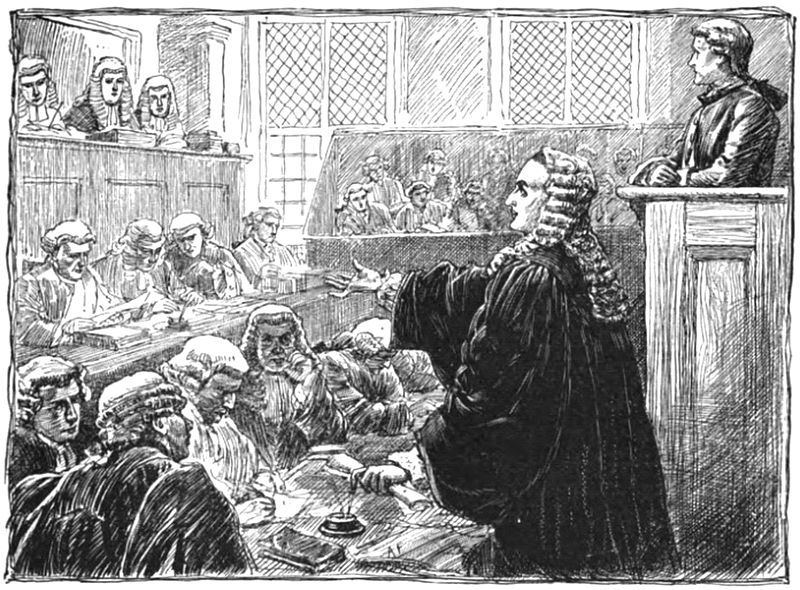
1883 sketch of the Zenger Trial. Image from Wikimedia Commons
In the 1730s, a journalist from Germany named Peter Zenger began printing a publication called the “New York Weekly Journal.” The publication criticized then-royal governor William S. Cosby, accusing him of rigging elections (sound familiar?) among a lot of other major misdeeds.
In 1733, Zenger was accused of libel. In those days, libel was any information that was opposed to the government, whether or not the information was true. During the trial, Zenger’s wife Anna kept the paper running, and her reports resulted in Zenger’s jury being replaced by a true jury of his peers rather than a jury specifically selected by the judge.
Zenger’s lawyer was the famous Andrew Hamilton, who argued that his client must be acquitted for for liberty’s sake. This was one of the cases that paved the way for the American Revolution and the eventual first amendment, which would make freedom of speech a cornerstone of American democracy.
This may not be a secret, per say, as the trial is immensely famous, but this story is too fascinating and relevant to leave off. Today, the definition of freedom of speech is being questioned again, and buildings like the Federal Hall and events like the Zenger trial are important reminders of the founding principals of democracy.
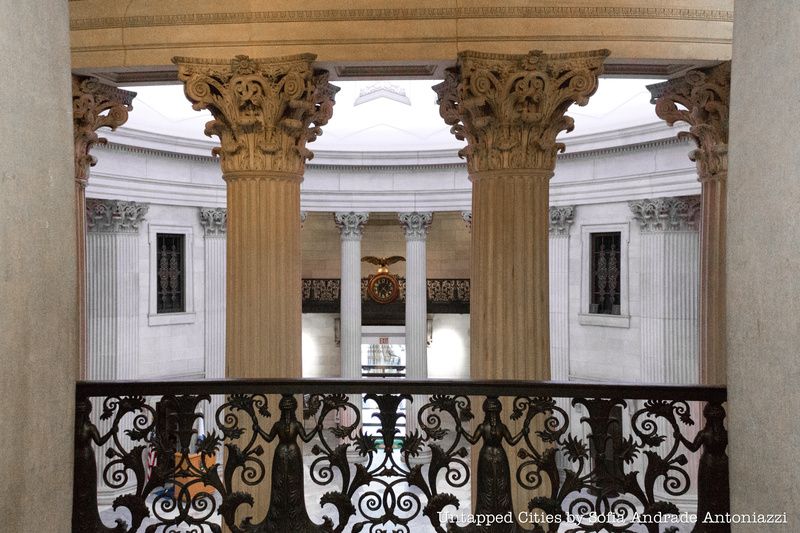
Charles L’Enfant redesigned Old City Hall in 1788, after the Constitution had been ratified. L’Enfant’s new design was met with criticism from the anti-Federalists, who accused it of being a symbol of Federalist aristocracy.
Many anti-Federalists called it “Fool’s Trap” and argued that its elegant design was merely an illusion designed to fool the masses into respecting a corrupt and wealthy government.
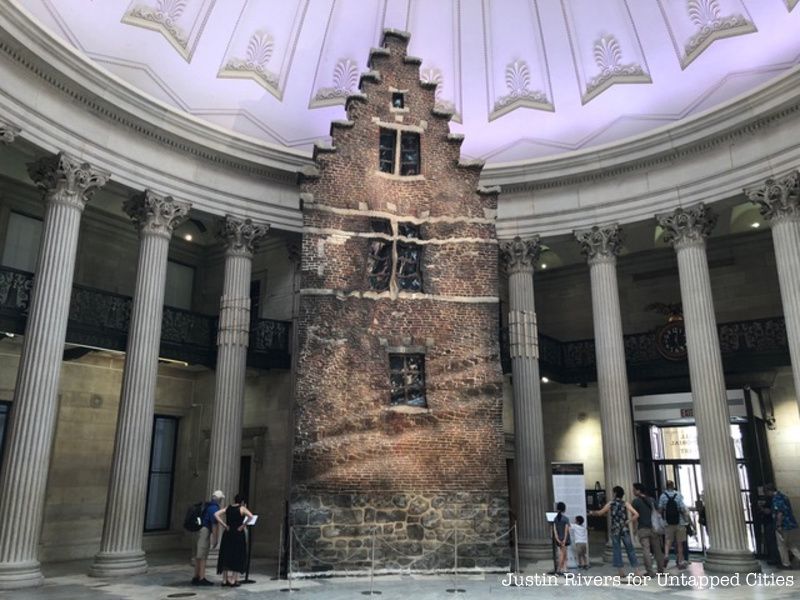
In 1741, thirteen fires ravaged New York City, one after the other, leading to a wave of mass hysteria—much like the kind that occurred during the Salem Witch Trials of the century before. 200 people were thrown into jail at the then-City Hall, and thirteen people were burned at stake and seventeen were hanged. Of the 35 that died, 30 were African Americans.
Before the fires, the fear and suspicion floating around New York had been brewing among whites plagued by racism and fears about job security. They feared that the growing slave population in New York, numbering roughly 11,000 at the time, along with the working-class whites, might be planning a mass revolt. When the thirteen fires broke out, so did a wave of mass hysteria and panic that culminated in the executions.
At ten o’clock on April 21, 1741, the Supreme Court of Judicature of the Province of New York convened at Federal Hall. The judge, Justice Phillipse, impelled a grand jury, which included seventeen impartial jurors—although one of the jurors was one of the men whose house had been burned down, leading historians to believe that some bias existed among them.
The first person to testify was sixteen-year-old indentured servant Mary Burton, whose initial reticence soon evaporated and was replaced by a convoluted story about a vast conspiracy involving two slaves who conspired to burn the town, killed any whites who tried to stop them, and aspired to become governor and king.
Two slaves named Quack and Cuffee were the first of the accused to be tried, and although both of their masters testified that the slaves were innocent and had been home that night, they were judged guilty.
On June 4, the trial drew a standing-room-only crowd as John Hughson and his wife Peggy Kerry—whose servant was Mary Burton—were tried on the basis of Burton’s testimony that her masters were conspiring to burn the city down. The Hughsons were Irish, another group feared by the majority of New York’s white inhabitants due to their Catholicism and the influx pouring into the country during this time. Hughson may have been inspired by the city’s Freemason’s club to form his own secret society which eventually plotted to burn the city. On June 12th, the Hughsons were executed. The case’s other purported ringleader, a slave named Caesar, was also hanged.
[post_featured_tour]

Photo by New York World-Telegram and the Sun Newspaper Photograph Collection via Library of Congress
On September 16, 1920, a bomb went off in Wall Street, killing thirty-eight people instantly and injuring 143 others. The perpetrators were never found, but investigators believe the attack was carried out by Italian anarchists called the Galleanists. The organization, which had been responsible for several bombings the year before, was anti-capitalist and pro-violence, as per the morals of its founder Luigi Galleani, who advocated for the use of warfare to eliminate tyranny.
Galleani was deported in 1919, but it is believed that his associates carried out the Wall Street bombing, which at that time was the deadliest act of terrorism on U.S. soil.
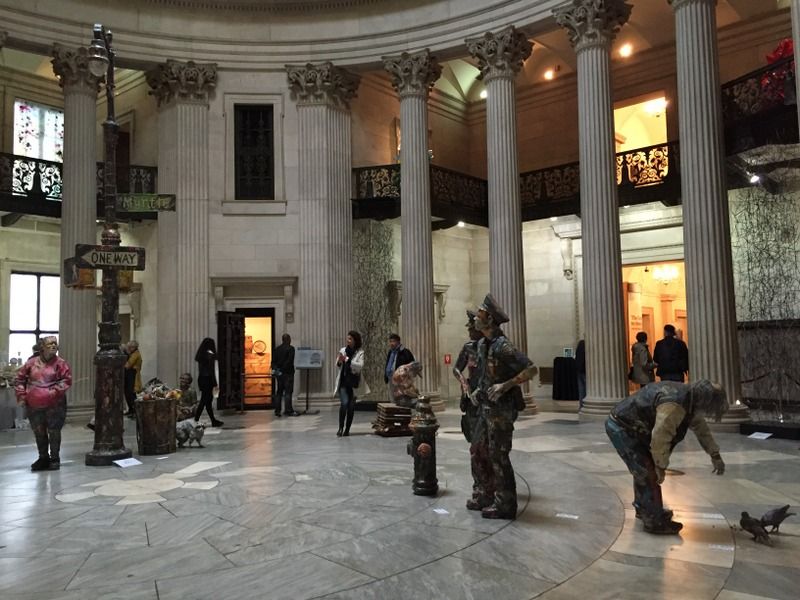
In 2015, Federal Hall was named a National Treasure. In 2016, a major restoration effort was announced, and $300,000 was set towards the preservation of the historical building. The work will include restoring bronze elements on the exterior, repairing dilapidated front steps, and adding architectural lighting.
The Federal Hall receives 200,000 visitors a year, but this number is dwarfed by the 15 million who pass by its doors each year. The National Park Service hopes to reestablish the Federal Hall’s position of importance in the public eye. The slogan “This Place Matters” has been a rallying cry for those attempting to preserve the building’s history and elevate its status and relevance.
Plans for the restoration that are currently in progress include a collaboration with museum and media firm Ralph Applebaum Associates, which organizes lectures, debates, media, and art performances in the space. A panel called the “Great Debate” has also been commissioned and is designed to foster discussions about the state of American democracy. Federal Hall’s Public Awareness Campaign, another major work in progress, has already managed to raise visitation by 45% in the summer of 2016.
The Hall was the location of Portal 2016, a street art installation that featured everyday street objects like signs, fire hydrants, wastebaskets, and more, made out of paper maché by the artist Will Kurtz. Portal was organized by 4heads, the team behind Governor’s Island Art Fair, and it was the first ever art installation inside the hall. Kurtz is working on a series of art pieces modeled after objects one might find on any given street in New York, such as benches from Brighton Beach.
Today, the building is a museum open to the public.
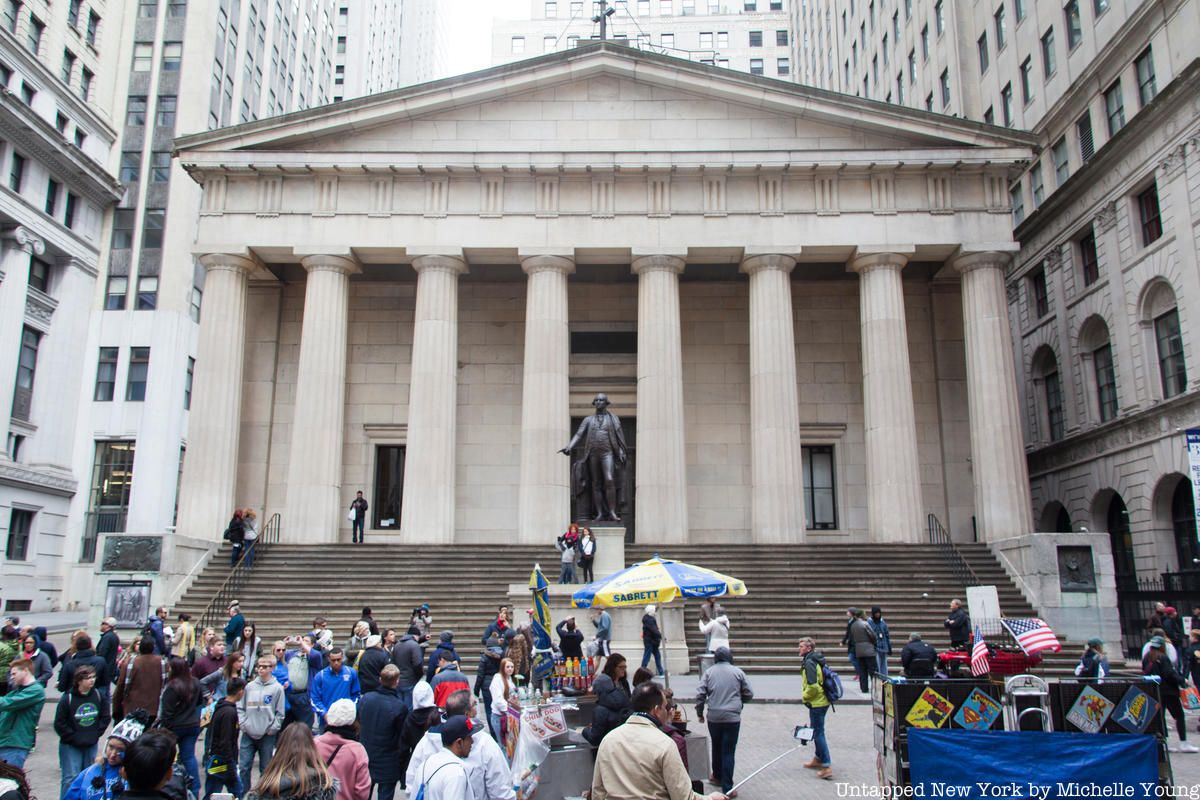
New York is one of the most common film locations for movies, with an estimated 22 major motion pictures taking place in the city made each year.
Federal Hall was used in the scene from the 1990 movie “Ghost” where Patrick Swayze, in spirit form, persuades Whoopi Goldberg to give away a four million dollar check. Its interior was also used in the 1987 movie “Wall Street,” which featured Michael Douglas and Charlie Sheen. “Wall Street’s directors were only allowed an hour inside the space, so had to move quickly to capture the footage they needed.
Additionally, a scene for the 2016 movie “Money Monster,” starring Julia Roberts and George Clooney, was shot in front of the famous building.
For more, check out this article that provides further detail about the major restorations to Federal Hall that began in 2016 and read more about the 224th anniversary of Washington’s inauguration.
Subscribe to our newsletter